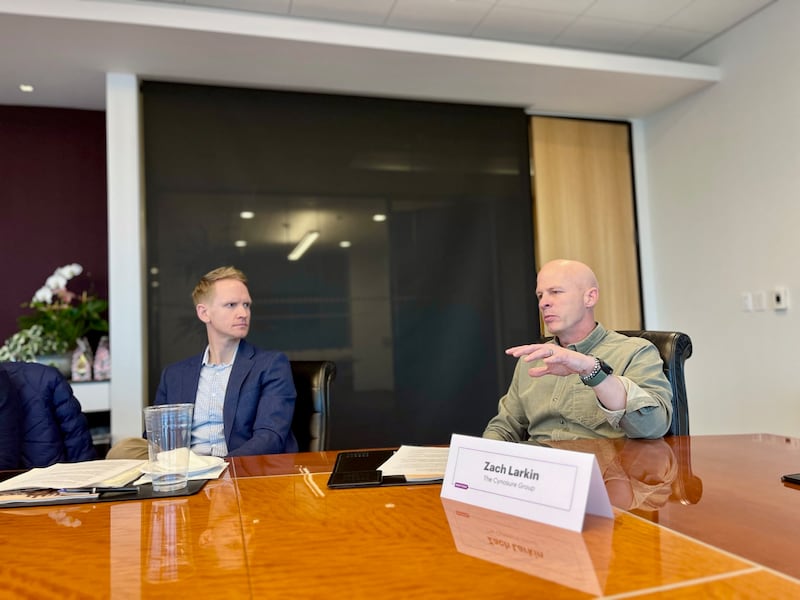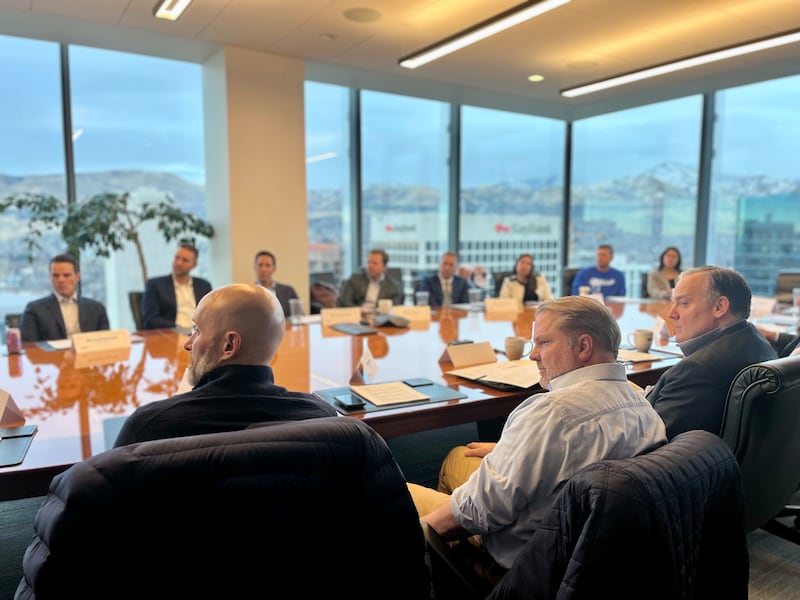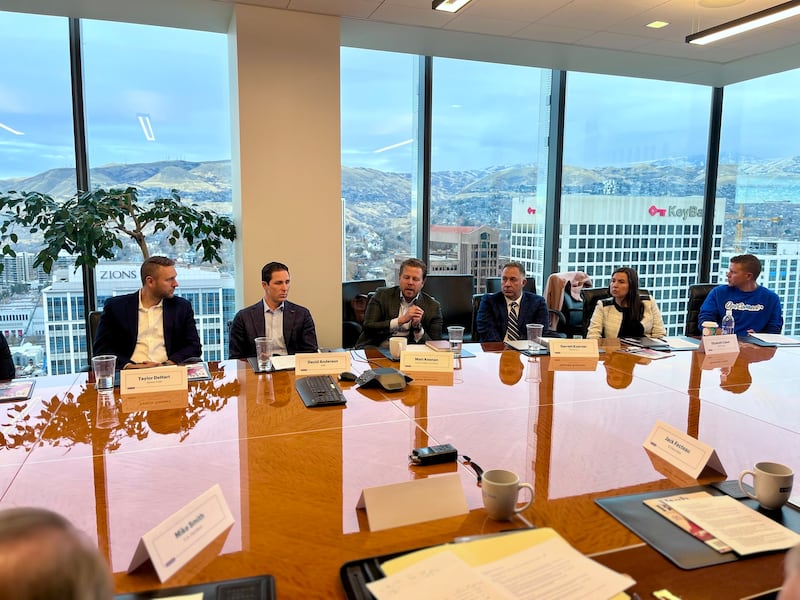Last month, Utah Business partnered with Dentons Durham Jones Pinegar to host a roundtable featuring Utah’s finance and business leaders. This conversation was moderated by James Morgan, managing director at Forbes Partners.
Discuss the background and lead-up to your transactions in 2024.
James McKean | Principal | Tower Arch Capital
It was an active year for us. We had a couple of platform investments and have done several add-on acquisitions. … In May, we closed on a company called ACS Manufacturing and then, in August, Miller Industries. … This year, we saw — as we probably all saw — high activity in the data center space and all the ancillary services products that go into it.
Johny Wudel | COO | JobNimbus
We build software for the home services space, primarily roofing contractors. We’ve done three acquisitions in the last three years, and in 2024, we were on the sell-side looking for an investment or a buyer and ran a full process. It was very rigorous; it started in January with fireside chats and concluded in November. There was a ton of interest and demand on the buy-side — a lot of pent-up capital — and it started with 25 strategics and 20 private equity sponsors. … We went with Sumeru Equity Partners. When it got down to it, the offers were in a wide range of multiples, even though we’d set a lot of expectations. What won the day was the belief in the future Sumeru crafted for us, and we totally aligned with what that future growth plan looks like.
Taylor DeHart | Principal | Savory Fund
The food and beverage industry is quite large — about a trillion dollars overall — and it’s constantly refreshing with a new set of entrants. A lot of people from the outside looking in think that’s risky. … That’s good news for us. We have a playbook that’s been instructed by 15-16 years of operating history. We know how to navigate the landmines associated with food and beverage. … The brands that have great financial performance, strong leadership teams and are in a growth factor that Americans want, we’ll continue to make investments into those brands.
Chris Baird | President & CEO | OptConnect
Capestone was our second deal this year. Our first was in a company by the name of M2M DataGlobal in Santiago, Chile, … then Capestone came and offered an expansion opportunity for us in Europe. … Within a month of closing Capestone, the phone started ringing. We’re in discussions with two [partners] in Europe right now and two here domestically. … We’re looking for the right market dynamics and the right profile margin within the business.

How has the current macro landscape altered your corporate outlook and appetite for growth via M&A?
Zach Larkin | Managing Director | The Cynosure Group
2024 was an active year for us. On the add-on side, we’ve seen a lot of founders we partner with who have relationships and have brought deals to the table. … From a valuation standpoint, one thing I’ve noticed is that businesses and founders become a bit more in line with where buyers are. … This year, we’ve seen more folks meet in the middle in terms of valuation.
Matt Keenan | SVP, M&A | The Larry H. Miller Company
We think next year will be a really good opportunity for us to see more deal flow. We think a lot of sponsor-backed assets are going to be in the maturity of year four and five, and you see the federal funds rate coming down as well. … There’s $2 trillion worth of dry powder sitting in the private markets, and we anticipate it being a very competitive environment. We also think that, on the front end, there were a ton of deals that were underwritten four to five years ago that will be coming into market. The other component that’s sitting out there is the baby boomer generation — aging and family, founder-owned businesses coming to market — and we anticipate seeing a lot of deal flow as it relates to that.
What are you seeing in the current credit market in terms of the ability to put money out, given the rate environment?
Matthew Dent | SVP, Enterprise Banker & Senior Relationship Manager | KeyBank
Private credit and direct lending have played an important role the last few years. A lot of banks, especially after the three failures in 2023 and the rising rate environment, have had to think about anticipated changes to liquidity requirements. The Fed has been very public about expecting changes for banks. Post-election, those changes are a little less certain, which is probably good news for lenders.
As we look at 2025, demand is going to be very, very high in terms of deal flow and our activity level. I think there’ll be a role for all types of lending, especially as multiples likely start to increase a little bit. There’s probably a role junior capital and senior debt can play together.
David Andersen | Market President | UMB Bank
The banks that have remained relevant in M&A transactions are those that have partnered with excellent capital providers, across both private equity and strategics. How do you define excellent? It’s those that understand where a bank fits in the capital stack. … For the most part, banks are lenders; they’re not equity providers. … Equity providers want to finish the race regardless of inconvenience or convenience in what’s going on, macro or micro. We’re not changing our posture when it’s macro-convenient based on issues that are going on in the banking world. You know the strength and character of your bank when they stick with it.

M&A advisors, what was the level of activity in your view? How are you looking at 2025 from a valuation and process competition perspective?
Michael Bennett | Managing Partner | Crewe Capital
2024 was better than I thought, but it still faced a lot of headwinds. As a firm, we did six transactions here in Utah. … I think that investor buy-side due diligence was really a lot more intense than we typically saw. Deals took a lot longer. I think there was a lot of caution going into the election, not knowing what was going to happen and how that could affect someone’s investment. … Since the election, we’ve already picked up a few new mandates, and almost every CEO we talk to is really optimistic.
Mike Smith | Managing Director, Investment Banking | D.A. Davidson & Co.
Maybe a little more contrarian view: If we looked in the mirror a year ago, I think everybody said, “Rates will fall sooner, and they will fall faster.” We only had two rate cuts for this whole year, and it took till the end of the year. I didn’t see anybody saying that. I think the idea that rates are going to fall as fast as we’d like them to next year is probably highly unlikely.
I think 2025 is going to be incrementally better. … I am more optimistic about 2026 in terms of a real step function of private equity needing to sell assets. The deals we’re doing a lot this year are what I’d call very aged assets. … I do see real optimism in sectors like data centers. … It’s not a broad-based lift of the M&A market. I hear people talk about certain veins of gold, whether it’s industrial, consumer, tech or home services — those are great, but it’s not across the board.
Jack Fecteau | VP | K2 Securities
We’ve had many, many conversations with business owners who are very interested in selling right now, but they have had one or two bad years in the short term — posting negative numbers, sometimes two years in a row. … Unfortunately, I think the standard conventional advice is going to be, “You should probably fix that with at least one full year, and then at least interim, before going back out to market.” Because of that, we’re talking to a lot of prospects right now where it looks like 2026 is going to be the go-to-market year.
I think, in two years, you might see the rates come down by about a little less than a percent based on what Wall Street’s betting on, but we’re never getting back to zero. … If your number is based on some valuation that you received back in 2021, you probably need to figure that out by growing yourself out of that hole, not by waiting for the market conditions to turn.
On the buy-side, what are people focused on from a valuation perspective? How does it relate to the COVID-19 years?
Garrett Koerner | Tax Partner | Tanner LLC
As a tax partner on the diligence side, there’s a lot of optimism with the change in the presidency. We’ll hopefully see something done in 2025 from an extension of TCJA [Tax Cuts and Jobs Act] and potentially rate impacts in that area.
Patrick McMillan | CFO & Transaction Advisor | Amplēo
One of the things that we are really seeing an uptick in is sell-side quality of earnings and due diligence and preparation. One of the things we talk about at our firm is that you should always be transaction ready. It’s just good business. The side effect of being transaction ready is that your business is going to have better policies and better procedures.
Everyone is focused on January 21st — changes at the FTC, thoughts on the Committee on Foreign Investment in the United States (CFIUS). Tell us about the regulatory environment and perceived risk. What are you telling clients?
Thomas R. Taylor | Shareholder | Dentons Durham Jones Pinegar
We’ve seen an interesting thing with the CTA, the Corporate Transparency Act. If you were a company that was incorporated or organized before January 1, 2024, you had to file by January 1, 2025 with the Department of Treasury’s FinCEN Department. That has now been enjoined, so the Corporate Transparency Act is off the table for the time being. I think we’re going to see Trump remove Lina Khan at the Federal Trade Commission. I think a lot of the antitrust regulations that have been put in place are going to get rolled back, and I hope they do. It’s very onerous to do a deal if you’re filing a Hart-Scott-Rodino (HSR). … Same with CFIUS. That can become very onerous, and you spend a lot of time and money if you have to make a CFIUS filing. I see a lot of that getting rolled back under the new administration.

What has to go right in 2025? What’s your overall outlook for the year ahead?
Johny Wudel | COO | JobNimbus
Specifically for strategics, I think it’s really important not to get enamored by the concept of M&A. … I do think, in tech, there is huge opportunity over the next couple of years to buy up point solutions.
Jack Fecteau | VP | K2 Securities
If you look at the last 50 years of M&A activity, there’s actually never been three years of negative M&A volume in a row. We had a negative year in 2023. It looks like 2024 will be another negative year, but just based on that pattern, people need to sell. They need to retire, and assets need to be divested. We think 2025 will be a pick-up.
David Andersen | Market President | UMB Bank
Our operating companies that haven’t yet done a transaction are looking forward to transactions in 2025. The other thing is a great platform will always be great regardless of what the interest rates do. … The investment is still going to happen, and there are ways to structure that to make a great deal and execute on a great transaction.
Thomas R. Taylor | Shareholder | Dentons Durham Jones Pinegar
I think we’re, for the most part, beyond COVID. The supply chain issues have been worked out, for the most part. We have baby boomers who continue to retire and want to exit their businesses. There’s at least $2 trillion of dry powder in equity capital available by private equity
for investment. … The bottom line is, there’s a ton of cash chasing good deals, and good deals are going to get done.



